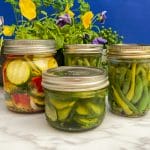Ten Steps to Quick Refrigerator Pickles – No Canning Needed
These refrigerator pickles are a quick and easy solution when you have extra veggies on hand or are interested in a tasty topping for your burgers, tacos, sandwiches or charcuterie board.
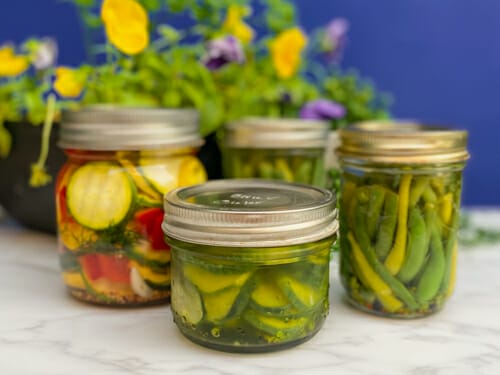
Also Read: Quick Pickled Onions, Canned Dilly Beans, Dill Pickles, Pickled Red Cabbage
What Are Quick Refrigerator Pickles?
Refrigerator pickles are vegetables marinated in a vinegar-based brine and stored in the refrigerator. They are “quick” because they take less than 15 minutes to prepare, do not require any type of canning process and are quick to disappear.
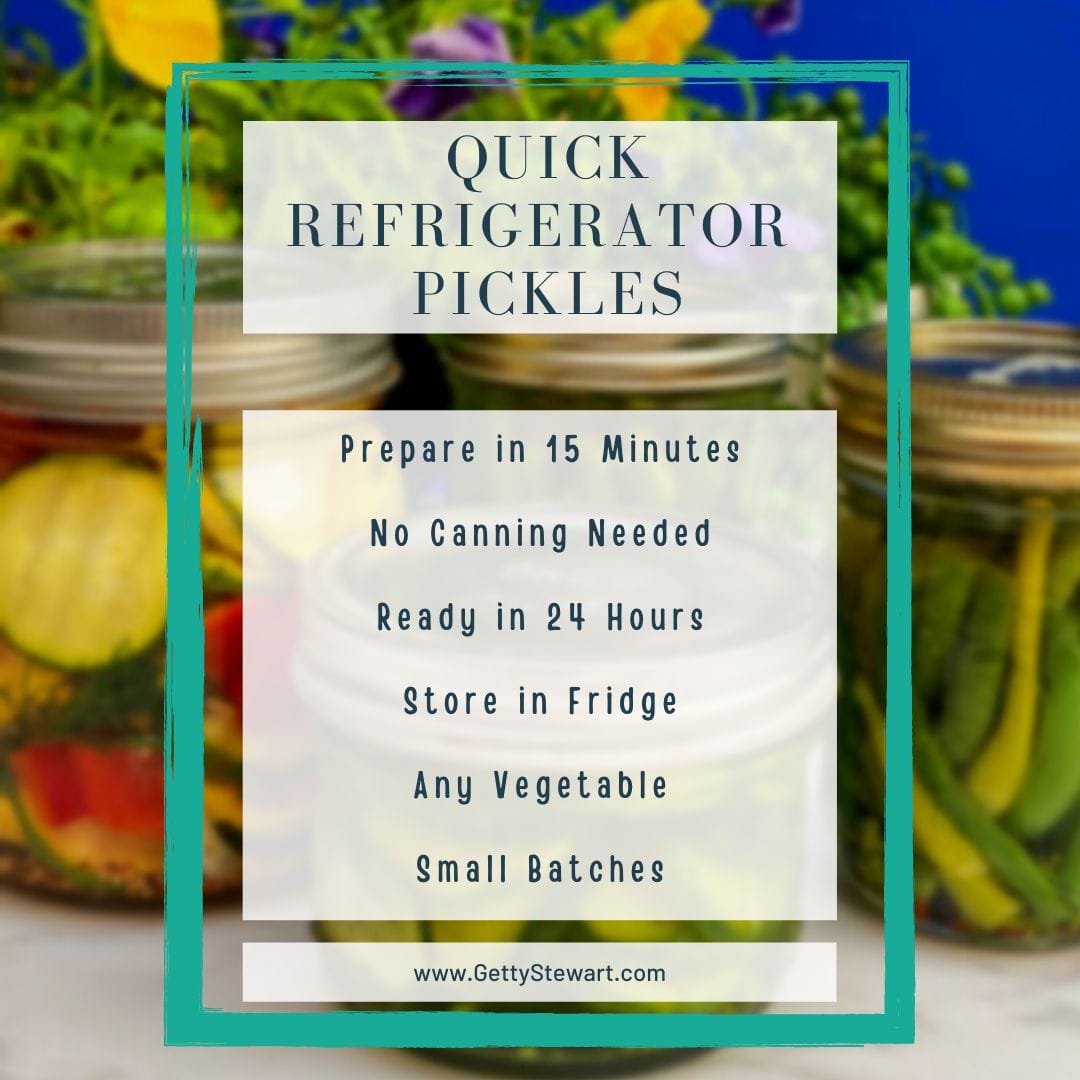
Quick refrigerator pickles MUST be stored in the fridge and usually do not last more than 3-4 weeks. Therefore small batches are preferred.
What about fermented pickles?
They are different than fermented pickles which rely on a starter liquid of salt, water and live organisms to form a living brine that produces acid which protects vegetables from harmful pathogens. Fermented vegetables are a healthy, probiotic food made without added acid (no vinegar or citrus juice). Making fermented pickles takes several weeks and careful attention. Fermented vegetables can be stored at cool room or refrigerator temperatures for several months.
What about canned pickled veggies?
Refrigerator pickles are also different than canned pickled vegetables stored in the pantry. Shelf-stable pickled vegetables also use a vinegar brine, but this brine uses very precise ratios of acid and salt to protect from harmful pathogens. Shelf-stable pickled vegetables must be heat processed using a hot water bath. Because specific amounts of acid are needed, use tested recipes from credible sources like National Centre for Home Food Preservation, Bernardin or sites like mine that rely on these sites for their recipes.
- Classic Dill Pickles – Hot Water Bath
- Pickled Beets – Hot Water Bath
- Dilly Beans – Hot Water Bath
- Pickled Hot Peppers – Hot Water Bath
Pro Tip: You can use any pickle recipe for refrigerator pickles, but you cannot use any refrigerator pickle recipe for canned pickles.
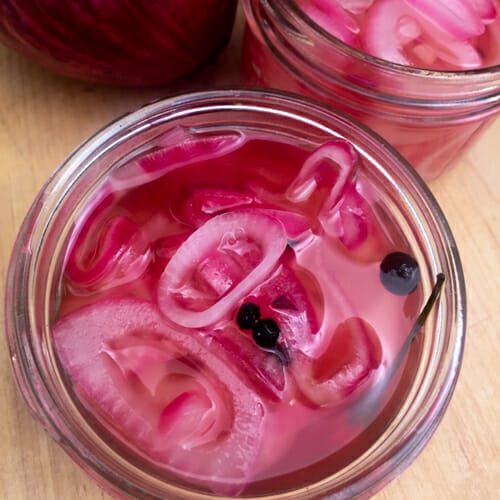
What Vegetables Can Be Quick Pickled?
It’s difficult to think of a vegetable that you can’t pickle! There are no safety reasons why you can’t quick pickle any vegetable, the limiting factor is taste and texture. But remember, they’re kept in the fridge for a short period. That said, the most common vegetables to pickle are:
- Cucumbers
- Green Beans
- Onions
- Carrots
- Beets
- Cauliflower
- Hot peppers
- Zucchini
- Cabbage
- Radishes
- Sweet peppers
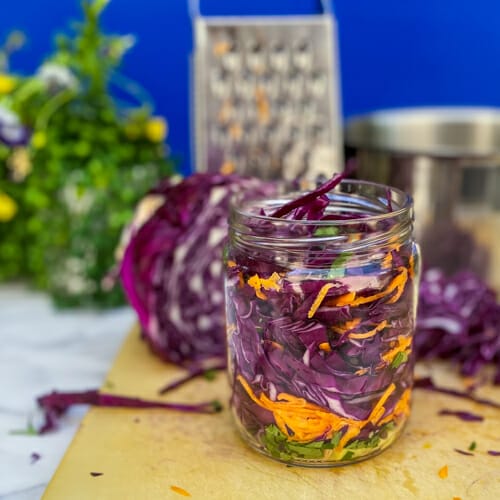
The Basic 10 Step Process
Making refrigerator pickles is very easy with no canning or sterilizing needed. You basically fill jars with veggies, top with brine and store in fridge. Here’s the step by step process.
- Wash and check jars & lids. (Any glass jar works, canning jars are not required).
- Trim, wash and prep veggies as desired. Green beans, onions, peppers and cauliflower can simply be washed and cut to size before adding to the jar. For crunchier texture, cucumbers and zucchini benefit from salting to draw out some of their water. Simply sprinkle with salt and let rest for 30 minutes, drain and wipe off salt then add to jars. Hard vegetables like carrots and beets will be more tender if blanched or cooked first, unless you use thin spears or shred them.
- Add flavour makers (herbs & spices) to jars. Use whatever combination you prefer to make it as spicy or sweet as you’d like.
- Tightly pack veggies into jars, leaving ½ inch space at top.
- Make the brine and boil to dissolve salt and/or sugar.
- Pour brine over veggies, covering veggies completely. Any parts sticking out may discolour or spoil.
- Tap jars to release any trapped air. Top up with brine if needed to cover veggies.
- Seal with lid, let cool to room temperature then refrigerate.
- Eat within 24-48 hours after flavours have infused somewhat.
- Store in fridge for a month.
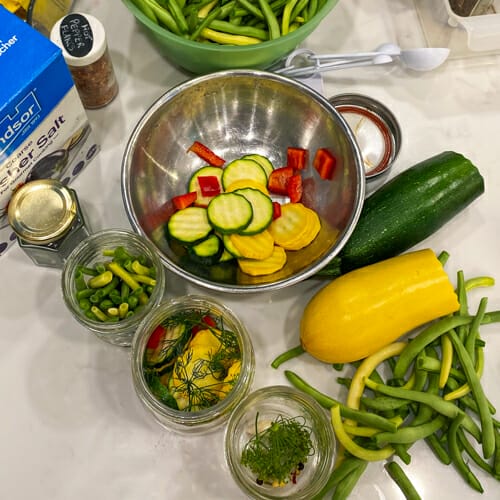
Helpful Quick Pickling Tips
- Begin with the end in mind by thinking of how you will use your quick pickles. This will help you decide what shape and size to cut your veggies and what herbs and spices to use.
- Use the freshest vegetables possible, the closer to harvest the better.
- Use pickling or kosher salt without any additives like anti-caking agents or iodine that can cause cloudiness. My recipes use coarse Kosher salt. If using fine grained salt, use less (I haven’t tested exact amount of fine salt).
- Use white vinegar, rice vinegar, apple cider vinegar or white wine vinegar with at least 5% acid. Red wine vinegar will work but it will colour your brine and veggies. Avoid malt or balsamic vinegar.
- Use soft water as hard water can cause cloudiness. If you know you have hard water, boil it for 15 minutes before using or use distilled water.
- Use whatever jars you have on hand, you don’t need official canning jars – old salsa jars are great.
- You can vary the amount of salt, but the less you use, the shorter the pickles will last in the fridge.
- You can omit sugar, add more or replace it with honey or stevia. (Sugar is used to balance acidity or to add sweetness. It is not a key preservative. It’s okay to change the amount or type of sweetener used).
- Use prepacked pickling spice for convenience or create your own spice combination.
- Some vegetables do benefit from blanching or prepping in some way before pickling. For example, beets are best pre-cooked.
Optional Veggie Prep
Quick refrigerator pickles aren’t intended for long term storage, so any prep is for personal preference. It’s up to you to decide how tender you want your veggies to be. You may want to consider the following prep – all optional.
- Soak onions in ice water to take out some of the sharp bite.
- Blanch or pre-cook veggies like beets, beans, cauliflower and carrots to soften and allow flavours to penetrate more easily.
- Salt high moisture veggies like cucumbers and zucchini for 30 minutes or longer to draw out moisture and add to crispiness. To reduce saltiness, rinse in plain water before using.
- Instead of salting, you can also soak cucumbers in ice water for added crispiness.
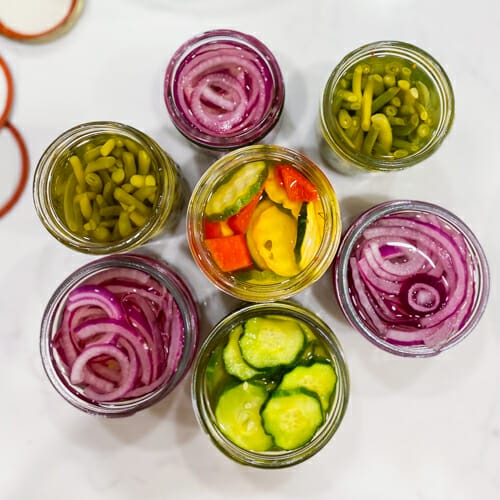
The Basic Brine Recipe
When I make quick pickles I use this basic brine as a starting point. This ratio of acid, salt and water will keep vegetables for up to one month in the fridge. It is a classic pickle brine with just enough sugar to balance the acid but not make vegetables taste sweet.
For refrigerator pickles, you can change this ratio pretty much any way you like with an understanding that reducing the acid level will mean your fridge pickles won’t last as long in the fridge.
This makes enough for two pint jars (500 ml/2 cups) or four half pint (250mL or standard jam jars). Simply bring all the ingredients to a boil to dissolve the sugar and salt.
For 2 Pint jars or 4 half pint jars
1 cup vinegar
1 cup water
1 Tbsp granulated sugar
1 Tbsp coarse Kosher salt
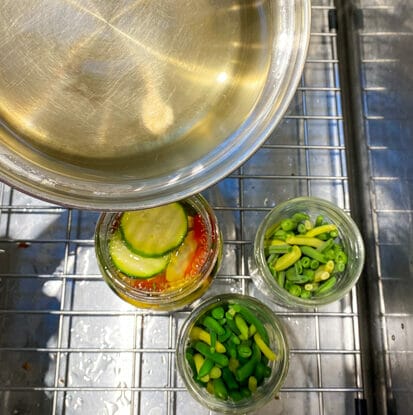
Pickling Herbs & Spices
Choose whatever herbs and spices you’d like. Stick with the classics or try something a little different. Add ingredients to the bottom of each jar to ensure they are evenly spread out. Mix your own or you can use pre-mixed, store bought pickling spice.
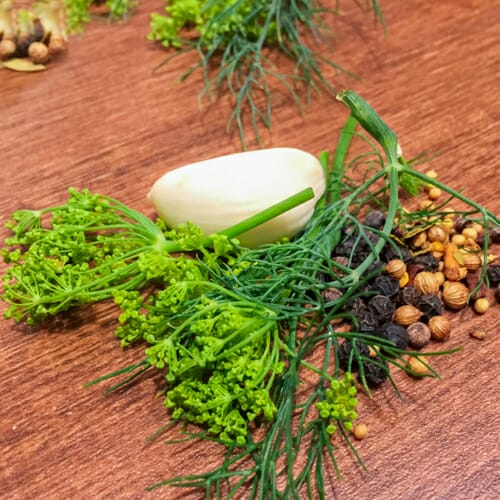
The Classics
- Dill
- Garlic
- Black peppercorn
- Mustard seed
- Coriander seed
- Allspice
- Bay leaf
- Hot pepper flakes
A Little Different
- Ginger
- Cilantro
- Thyme
- Turmeric – will colour brine & veggies
- Hot Peppers
- Citrus Zest
- Rosemary
- Horseradish
Putting it All Together – Quick Refrigerator Pickles
Quick Refrigerator Pickles – Classic Dill Flavour
Ingredients
- 2 cups prepared vegetables (your choice)
- 4 sprigs fresh dill
- 2 cloves garlic
- 6 allspice berries
- 6 black peppercorns
- 1/2 tsp yellow mustard seeds
- 1/2 cup white vinegar
- 1/2 cup water
- 1 tsp sugar
- 1 tsp coarse kosher salt*
Instructions
- Wash and check jars and lids for cracks or chips.
- Trim, wash and cut vegetables to desired size so there is half inch of space between top of jar and top of vegetables. For example, if making spears or using green beans, cut about 3 inches long to fit a regular jam jar. If pickling carrots or beets, pre-cook in boiling water until fork tender – or cut thin slices.
- Divide dill, garlic, allspice berries, peppercorns, and mustard seeds between jars.
- Tightly pack veggies into jars, leaving ½ inch space at top.
- Make the brine by combining vinegar, water, salt and sugar in a pot. Bring to boil, stirring to dissolve salt and sugar.
- Pour brine over veggies, covering veggies completely. Tap jars to release any trapped air. Top up with brine if needed to cover veggies. If you run out of brine, use up to 2 Tbsp water in each jar.
- Seal with lid, let cool to room temperature then refrigerate.
- Wait for 24-48 hours or longer to let flavour infuse and balance.
- Store in fridge for up to one month.
Notes
Nutrition Facts (per serving)
More Recipes
Here are my favourite pickle recipes.
- Pickled Red Cabbage – use as refrigerator pickles only
- Pickled Beets – use as refrigerator pickles or make shelf stable with Hot Water Bath
- Classic Dill Pickles – use as refrigerator pickles or make shelf stable with Hot Water Bath
- Dilly Beans – use as refrigerator pickles or make shelf stable with Hot Water Bath
- Pickled Hot Peppers – use as refrigerator pickles or make shelf stable with Hot Water Bath
- Pickled Red Onions – use as refrigerator pickles only
Okay, my friends, that’s all I have for you today. All this writing may make it seem more complicated than it is. Trust me, once you do it, you’ll be laughing at how easy these quick refrigerator pickles are. The only question remains – what are you going to pickle first?
Happy quick pickling!
Sign up to get articles by Getty delivered to your inbox. You’ll get recipes, practical tips and great food information like this. Getty is a Professional Home Economist, speaker and writer putting good food on tables and agendas. She is the author of Manitoba’s best-selling Prairie Fruit Cookbook, Founder of Fruit Share, a mom and veggie gardener.



